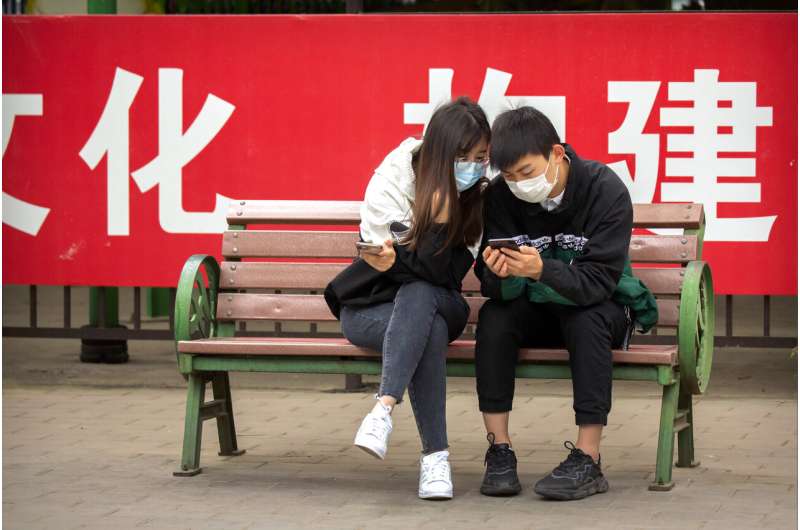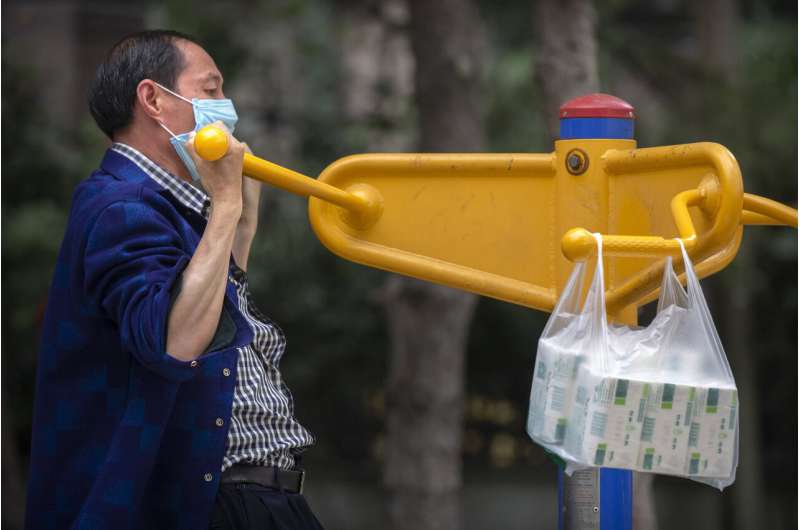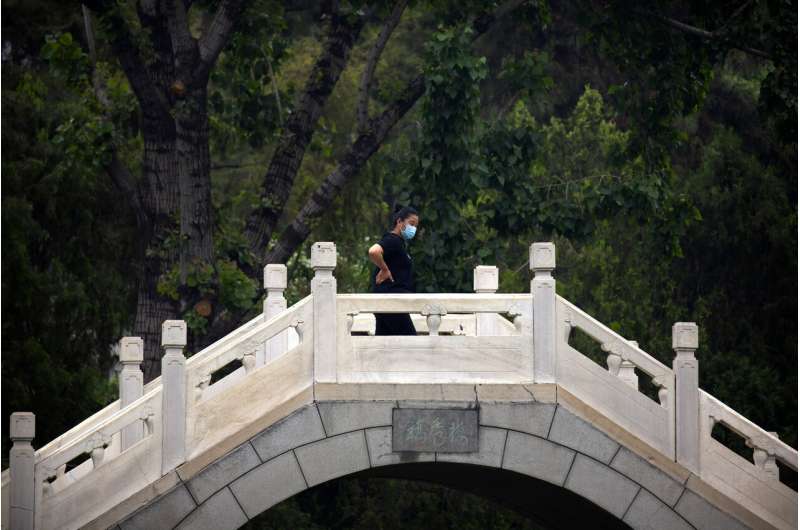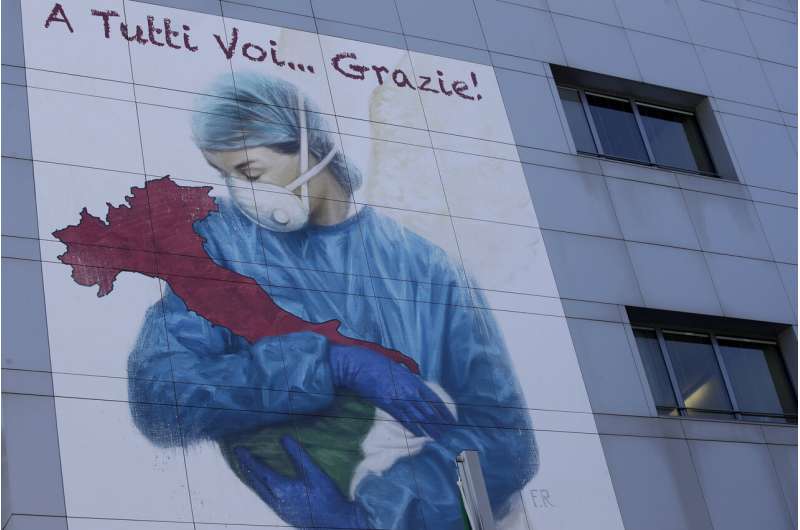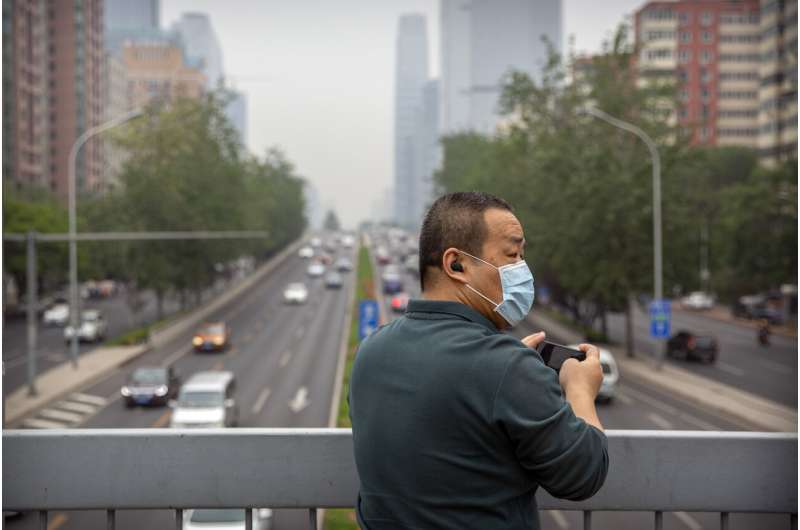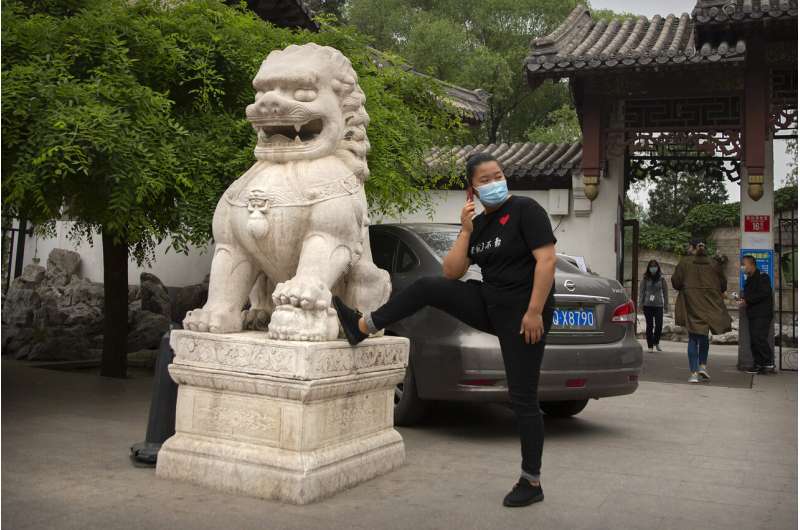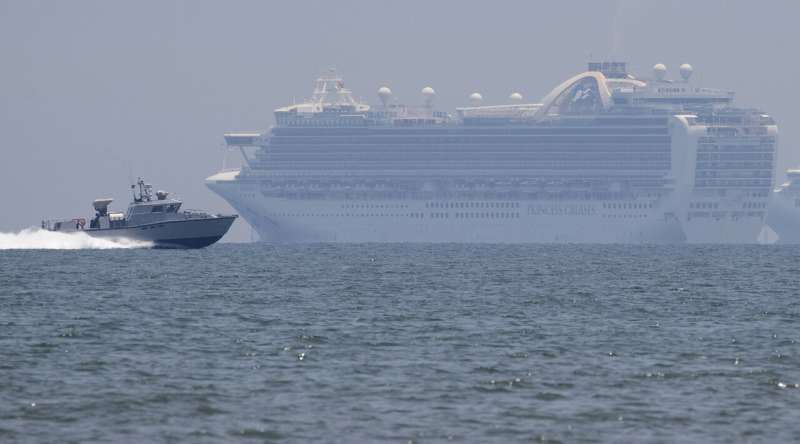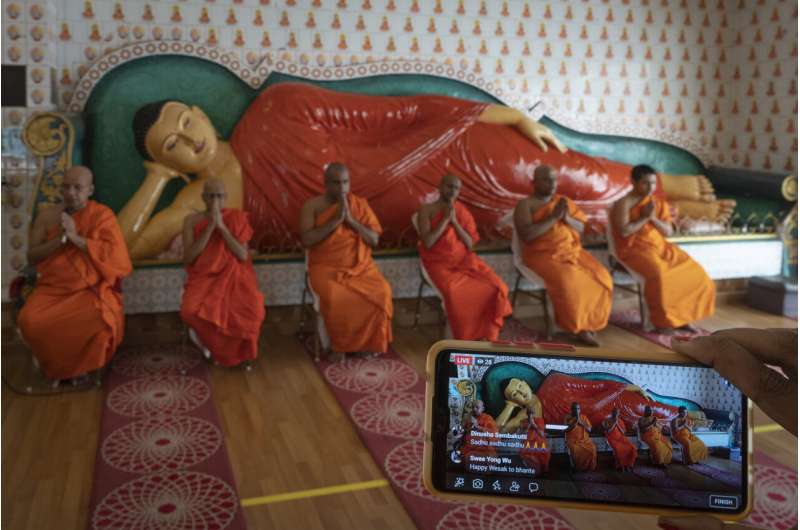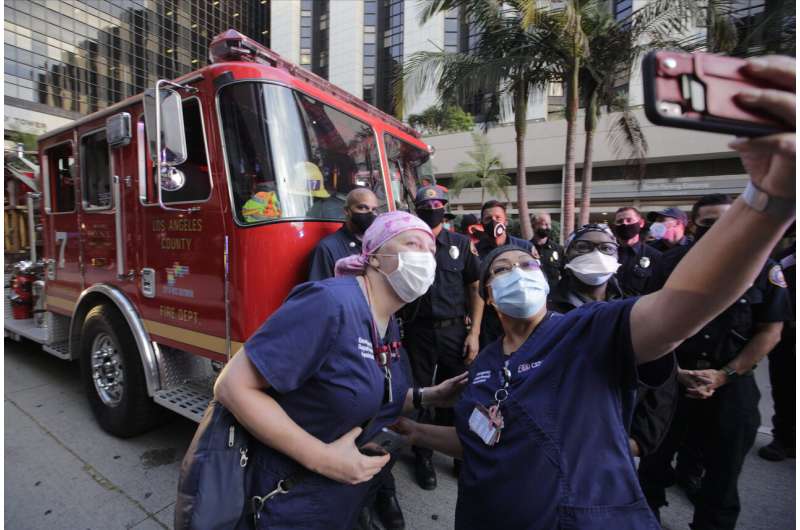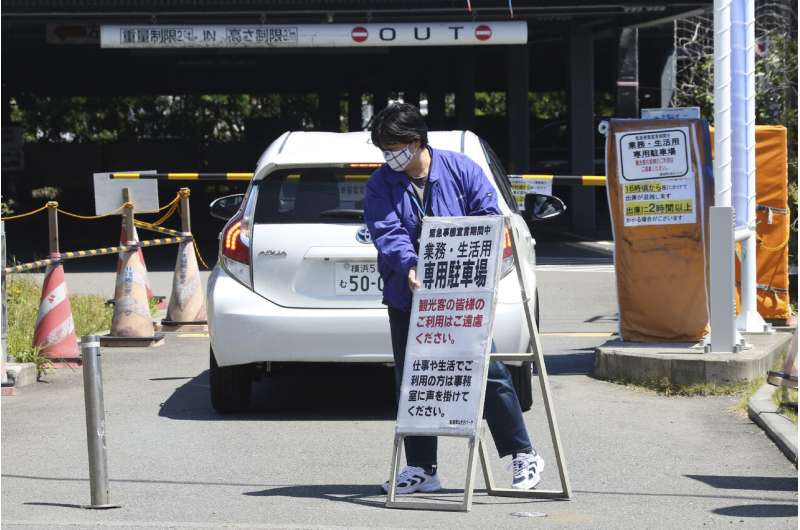People wearing face masks to protect against the spread of the new coronavirus sit on a bench in front of a propaganda banner encouraging people to wear masks at a public park in Beijing, Thursday, May 7, 2020. China's government declared the whole country now at low virus risk Thursday as its new cases fall to near zero and no new deaths have been reported from COVID-19 in more than three weeks. (AP Photo/Mark Schiefelbein)
Britain was expected to extend its nationwide lockdown on Thursday, but the European country hit hardest by the coronavirus plans cautiously to ease some restrictions on economic and social activity next week as it tries to reopen without sparking a devastating second wave of infections.
Authorities in many countries are drawing up plans for how to cope with a resurgence in outbreaks even as they slowly work to reopen businesses and resume other activity halted to combat the pandemic.
In Germany, which has begun to emerge from lockdown, authorities have begun drawing up plans to cope with any resurgence of the virus and experts in Italy doubled down on finding new victims and tracing their contacts. France, which hasn't yet eased its lockdown, has already worked up a "reconfinement plan" in the event of a new wave.
The U.K.'s official COVID-19 death toll stands at 30,076, second only to the United States, and Prime Minister Boris Johnson said it would be a "disaster" if the U.K. reopened too soon and triggered a second spike in infections.
Britain's lockdown, which allows people to leave home only for essential errands, shopping and exercise, was imposed March 23, initially for three weeks, and later extended to Thursday. It is expected to remain in place at least until Sunday, when Johnson plans to set out a roadmap for "phase two" of the outbreak.
A man wearing a face mask to protect against the spread of the new coronavirus uses exercise equipment at a public park in Beijing, Thursday, May 7, 2020. China's government declared the whole country now at low virus risk Thursday as its new cases fall to near zero and no new deaths have been reported from COVID-19 in more than three weeks. (AP Photo/Mark Schiefelbein)
The U.K. government has said gradual loosening measures will include more road space to walk and cycle while maintaining social distancing, and encouragement for sectors including construction to get back to work.
China, where the virus emerged late last year, declared its coronavirus risk level is now low. China's National Health Administration reported just two new cases on Thursday, both from overseas, and said the whole country now is at low risk of further infections after confirming no new deaths from COVID-19 in more than three weeks.
The last place downgraded from high to low risk in China was a county adjacent to the Russian border where the most recent spike in cases had been reported.
Amid a bitter spat with the U.S. administration over blame for the pandemic, Beijing touted its assistance to countries struck by the coronavirus, saying it has provided direct government aid to 150 nations, including millions of testing kits and pieces of personal protective equipment.
A woman wearing a face mask to protect against the spread of the new coronavirus walks across a bridge at a public park in Beijing, Thursday, May 7, 2020. China's government declared the whole country now at low virus risk Thursday as its new cases fall to near zero and no new deaths have been reported from COVID-19 in more than three weeks. (AP Photo/Mark Schiefelbein)
China has in part promoted its assistance and role as a source of personal protective equipment as a way to deflect criticism that it delayed reporting information about the outbreak first detected in the central industrial city of Wuhan late last year.
Beijing has angrily denied such accusations, saying it has been open and transparent throughout the crisis and that countries such as the U.S. squandered the opportunity China provided them to better prepare.
Strict social distancing also appears to have vanquished the outbreak in the remote island nation of New Zealand, where Prime Minister Jacinda Ardern outlined plans for further relaxing lockdown rules, with a decision coming perhaps next week.
New Zealand would keep its borders shut, restrict gatherings to 100 people or less and hold professional sports events without spectators. Masks and other precautions would be required as restaurants and schools reopen, she said. But Ardern called for vigilance.
In this March 16, 2020, file photo, a giant image of a drawing by Venetian artist Franco Rivolli showing a doctor with wings on her back cradling Italy and writing in Italian reading "To all of you... Thank you!", is displayed on the facade of Bergamo's Papa Giovanni XXIII hospital, in Bergamo, northern Italy. After two months of nightly briefings with only male COVID-19 experts, female scientists in Italy have demanded the government listen to their voices, too. Female lawmakers and a "give us voice" grassroots movement that has sprouted are lending support. (AP Photo/Luca Bruno, File)
"We think of ourselves as halfway down Everest," Ardern said. "I think it's clear that no one wants to hike back up that peak."
Worldwide, the virus has infected more than 3.6 million people and killed over a quarter-million, according to a Johns Hopkins University tally, which experts agree understates the dimensions of the pandemic because of limited testing, differences in counting the dead and concealment by some governments.
Public health officials in the U.S. say they are worried as about half of states ease their shutdowns, with cellphone data showing that people are becoming restless and increasingly leaving home.
Many states have not put in place the robust testing that experts believe is necessary to detect and contain new outbreaks. And many governors have pressed ahead with reopening before their states have met one of the key benchmarks in the administration's guidelines for reopening—a 14-day downward trajectory in new infections.
A man wearing a face mask to protect against the spread of the new coronavirus stands on a pedestrian bridge over a highway in Beijing, Thursday, May 7, 2020. China's government declared the whole country now at low virus risk Thursday as its new cases fall to near zero and no new deaths have been reported from COVID-19 in more than three weeks. (AP Photo/Mark Schiefelbein)
"If we relax these measures without having the proper public health safeguards in place, we can expect many more cases and, unfortunately, more deaths," said Josh Michaud, associate director of global health policy with the Kaiser Family Foundation in Washington.
Newly confirmed infections per day in the U.S. exceed 20,000, and deaths per day are running well over 1,000.
Researchers recently doubled their projection of deaths in the U.S. to about 134,000 through early August. So far the U.S. has recorded over 70,000 deaths and 1.2 million confirmed infections, while Europe has reported over 140,000 dead.
Facing re-election with the economy engulfed in its worst slowdown since the Great Depression of the 1930s, President Donald Trump has encouraged states to reopen.
Adding to pressure to revive activity: The U.S. unemployment rate for April, which comes out Friday, is expected to hit a staggering 16%.
-
A woman wearing a face mask to protect against the spread of the new coronavirus stretches her leg on a statue in Beijing, Thursday, May 7, 2020. China's government declared the whole country now at low virus risk Thursday as its new cases fall to near zero and no new deaths have been reported from COVID-19 in more than three weeks. (AP Photo/Mark Schiefelbein)
-
A Philippine military boat passes by the cruise ship Ruby Princess as it is anchored in Manila Bay, Philippines, Thursday, May 7, 2020. The Ruby Princess which is being investigated in Australia for sparking coronavirus infections, has sailed into Philippine waters to bring Filipino crewmen home. (AP Photo/Aaron Favila)
-
Temple staff use mobile phone to live-stream a blessing service in conjunction with Vesak Day, known as the Buddha's birthday, at Maha Vihara temple in Kuala Lumpur, Malaysia, on Thursday, May 7, 2020. As the pandemic sweeps across the nation and the globe, Malaysians are becoming familiar with the new normal under the Movement Control Order, a localized quarantine, to curb the spread of the coronavirus. (AP Photo/Vincent Thian)
-
Nurses take selfies with first responders who stopped during a parade outside Cedars-Sinai Medical Center in a show of support for nurses and health care workers on National Nurses Day, in West Hollywood, Calif., Wednesday, May 6, 2020. AP Photo/Damian Dovarganes)
-
A parking lot employee removes a notice for tourists in Fujisawa near Tokyo, Thursday, May 7, 2020. Prime Minister Shinzo Abe announced that Japan will extend a state of emergency until end of May. (AP Photo/Koji Sasahara)
But experts say the U.S. lacks the armies of public health workers required for aggressive contact tracing to stem outbreaks.
A century ago, the Spanish flu epidemic's second wave was far deadlier than its first, in part because authorities allowed mass gatherings from Philadelphia to San Francisco.
Awareness of such risks has led some places, like hard-hit New York City, to adopt a cautious approach to reopening.
"My message to the rest of the country is learn from how much effort, how much discipline it took to finally bring these numbers down and follow the same path until you're sure that it's being beaten back," New York Mayor Bill de Blasio told CNN.
"If this thing boomerangs, you're putting off any kind of restart or recovery a hell of a lot longer," he said.
© 2020 The Associated Press. All rights reserved. This material may not be published, broadcast, rewritten or redistributed without permission.
